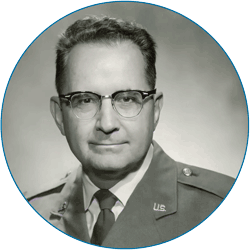 | John P. Stapp, MD, PhD, Col. USAF In Memoriam |
Dr. John Paul Stapp was a trailblazing figure who reshaped safety standards in both aerospace and automotive domains. From his early days in Northern Brazil until his death in New Mexico in 1999, Dr. Stapp demonstrated a life-long commitment to medicine and made noteworthy contributions to the ark of human knowledge. These contributions came by way of well known aphorisms and scientific laws, the advent of accelerations testing and wind blast experimentation, as well as institutes and associations bearing his name and continuing to work towards the increased safety and well-being of all mankind.
Education
Stapp’s attended high school in Texas at Brownwood High School. He received his Bachelor’s and Master’s degrees at Baylor University in 1931 and 1932, respectively, before pursuing a PhD in pursued a Master’s Degree in Zoology at Baylor University, followed by a Ph.D. in Biophysics from the University of Texas – Austin and an MD from the University of Minnesota – Twin Cities in 1944. He interned at St. Mary’s Hospital in Duluth, Minnesota, for one year.
Military Career
In 1944, Dr. Stapp went on active duty as a First Lieutenant in the Medical Corps, where his medical training earned him a position as a flight surgeon, thus initiating his research journey in aerospace medicine. His first assignment involved field-testing a liquid oxygen aircraft breathing system, exposing him to the challenges of high-altitude aviation and leading to preventive measures for altitude-related health issues.
Pioneering Research
After completing his required service as a reserve officer, Dr. Stapp extended his stay in the Medical Corps with a new mission—to determine human tolerance to deceleration and enhance protection from crash forces. The rocket-sled, accelerating 1,200 feet on tracks to replicate aircraft landing speeds, underwent intense aircraft crash deceleration. Ingeniously, metal scoops beneath the sled engaged with a water trough for a controlled slow-down. Thirty-two rocket runs with a dummy passenger preceded Dr. Stapp’s daring first ride in December 1947. By May 1948, he had completed an astounding 16 rides in the backward-facing position, enduring g stresses up to 35 times the pull of gravity (35 G’s)—double the previously set limit. These experiments definitively demonstrated the efficacy of backward-facing seats, offering air transport passengers optimum crash protection.
In June 1951, Dr. Stapp returned to Wright Field and, two years later, relocated to Holloman Air Force Base in New Mexico. There, he had access to state-of-the-art laboratory buildings, adequate equipment, and a qualified staff for further experiments in biodynamics. In a jaw-dropping feat in 1954, he rode the “Sonic Wind” at an incredible 632 miles per hour, coming to a dead stop in just 1.4 seconds. Subjected to over 40 times the pull of gravity (40 G’s), Colonel Stapp’s demonstration proved the survivability of windblast and deceleration of ejection from aircraft traveling at 1,800 miles an hour and 35,000-foot altitude. Time Magazine rightfully recognized him as “the fastest man on earth and No. 1 hero of the Air Force” in its September 12, 1955 issue.
While stationed at Holloman, Colonel Stapp observed a concerning trend—the Air Force was losing nearly as many men in fatal auto accidents as in plane crashes. This realization prompted him to initiate a comprehensive car-crash study program, involving the use of dummies in salvaged autos projected into wood and concrete barriers. Brave human volunteers tested safety belts, enduring forces up to 28 G’s or 4,800 pounds of decelerative force—an embodiment of Colonel Stapp’s unwavering commitment to advancing safety in both aviation and automotive realms.
Contributions to … Aphorisms?
Dr. Stapp notoriously kept a journal of aphorisms and adages encountered and created during his life of ground-breaking work. He regularly shared this collection with his research community, and a selection therefrom was published in 1992. Famously, what came to be known as Murphy’s Law is attributed to this collection, as well as Stapp’s Law, which states that “The human aptitude for ineptitude makes any human accomplishment an incredible miracle.”
Awards
Colonel Stapp’s remarkable contributions garnered numerous awards and citations, including the Legion of Merit with Oak Leaf Cluster, the Air Force Cheney Award, the National Medal of Technology and Innovation (awarded by George W. Bush), and the Outstanding Achievement Award from the University of Minnesota.
Further Reading
For further reading on Dr. John Paul Stapp or any of his many accomplishments, check out these related pages.
- The Man Behind High-Speed Safety Standards – National Air and Space Museum
- John Stapp, Testing Pioneer – Air Force Test Center
- John Paul Stapp: A Real-Life Rocket (Sled) Man – Popular Science
| Stapp Association | Stapp Journal | Stapp Conference | Contact Us |
|---|---|---|---|
Keep up to date on the latest news and publications from the Stapp Association, Journal and Car Crash Conference Join the Mailing List | Publications Aims & Scope Rights & Permissions Editorial Board Author Resources | Current Conference Past Conferences Short Communications Conference Assets Awards | Become a Sponsor Contact the Editors Web Support |